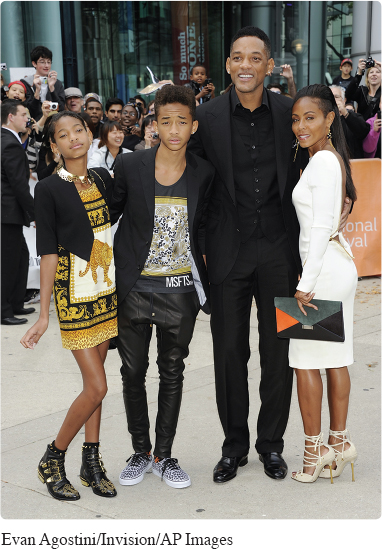Family Relationships
Families today are incredibly diverse. Since 2010, only 20 percent of U.S. households consist of married couples with biological children; within Canada, it is only about 35 percent. Couples are increasingly living together rather than getting married, and rising divorce and remarriage rates have led to blended arrangements featuring stepparents and stepchildren. Adding to this complexity, individual families are constantly in flux, as children leave home, then move back in with parents while looking for work; as grandparents join the household to help with day care or receive care themselves; and as spouses separate geographically to pursue job opportunities (Crosnoe & Cavanagh, 2010).
226
Will Smith and Jada Pinkett Smith may be best known for their successful acting careers, but being an entertainer is an identity shared by their children, Jaden and Willow Smith, who also perform in the music and film industries.

To embrace this diversity, we use a broad and inclusive definition of family. A family is a network of people who share their lives over long periods of time and are bound by marriage, blood, or commitment; who consider themselves a family; and who share a significant history and an anticipated future of functioning in a family relationship (Galvin, Brommel, & Bylund, 2004). This definition highlights three characteristics that distinguish families from other relationship types: shared identity, multiple roles, and emotional complexity.
Shared Identity. Families possess a strong sense of shared identity: “We’re the MacTavish clan, and we’ve always been adventurous” or “We Singhs have a long history of creative talent.” This sense of shared identity is created by three factors, the first of which is how the family communicates (Braithwaite et al., 2010). The stories you exchange and the way members of your family deal with conflict and talk with one another all contribute to a shared sense of what your family is like (Tovares, 2010). For instance, our friend Lorena’s great-
In addition to how a family communicates, genetic material can further foster a sense of shared identity (Crosnoe & Cavanagh, 2010). This can lead to shared physical traits—
Finally, a common history can also help create a sense of shared identity (Galvin et al., 2004). Such histories can stretch back for generations and may feature family members from a broad array of cultures. In The Descendants, for instance, Matt King’s family is incredibly diverse but bonded by their heritage as native Hawaiian royalty. The history you share with your family is created jointly as you go through time together. For better or worse, everything you say and do becomes a part of your family history.
227
Multiple Roles. Family members constantly juggle multiple roles (Silverstein & Giarrusso, 2010). When you’re a lover, a friend, or a coworker, you’re just that: lover, friend, or coworker. Within your family, however, you’re not just a daughter or a son—
Emotional Complexity. It is commonly thought that people should feel only positive emotions toward their family members (Berscheid, 2002). As psychologist Theodor Reik (1972) notes, people are “intolerant of feelings of resentment and hatred that sometimes rise in [them] against beloved persons—